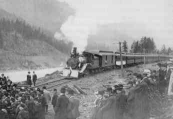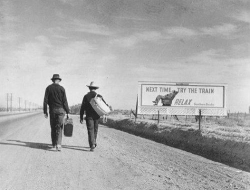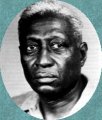 Freight
Train Blues
Freight
Train Blues
Towards the end of the nineteenth century, there
was fierce competition in America between the two major railroad companies,
the Union Pacific the Central Pacific. Soon
the silent lands that had been the province of nomadic Native Americans,
fur traders, and explorers gave way to the bustle of surveyors, graders,
trestle builders, tunnel blasters, and spikers. Thousands of workers, including
Civil War veterans and immigrants, were enlisted to do the back-breaking
work of laying track across the treeless deserts and through towering granite
mountains, and on May 10, 1868, a telegraph key clattered out a message
indicating
the line's completion. During the  next
two decades, railroads experienced their greatest growth, adding 176,000
kilometers to the system and eventually constructing seven transcontinental
rail routes.
next
two decades, railroads experienced their greatest growth, adding 176,000
kilometers to the system and eventually constructing seven transcontinental
rail routes.
You may be wondering what railroads have to do with the blues. You may have also wondered why so many blues songs are often about freight trains or have train in their title. May I suggest that to be interested in blues music necessitates an interest in its history. The history of the blues is the history of the American negro which is rooted in the deep south of America in the cotton fields of the Mississippi Delta. It is a story of survival, existence, sublimation, degradation and abuse.
In the 1930s the coloured people of the south were treated worse than dogs. Even when slavery was abolished, negro families remained in the south virtually as slaves due to the share cropping system on the cotton farms. They were never allowed to get out of debt and so remained tied to the white farmer. It was worse in the townships with Jim Crow being practised as segregation was known.
When the summer cotton crop had been cleaned out,
the male members in these families had little option but to travel north
looking for casual work. Many negro men were goaled or killed for the slightest
misdemeanour, even for looking sideways at a white person or being on the
streets after eleven at night, so they often became goalbirds and outcasts.
The KKK were very active at this time and their greatest joy was
to hang a black man or better still two. There is little wonder that many
negro men travelled north looking for work and attempting to escape
persecution. 
The only way that these men were able to travel was by jumping the freight trains. For many it became a way of life, the only way to survive. It was known as riding the rails or riding in a box car, nose to the open air. Many began riding trains around the age of seventeen during the 1930s, like Steamtrain Maury and the Sidedoor Pullman Kid. They would hop on a train one day and keep on riding, checking in with their families over the years. The hobos tell of backdooring, knocking on doors to ask for a bit of food in exchange for an odd-job. They tell of mean dicks and bulls, railroad police who would club or shoot hobos seemingly for the sport of it. And they tell of life in the jungle, the hobo encampments where etiquette was carefully observed and a meal of mulligan stew being a communal effort with bread, meat and vegetables contributed by all. But, most of all, they are portrayed as reputable, decent type of human beings.
Violence wasn't as widespread when rail-riding began. Female hobos could ride without trouble and men didn't need to fear for their lives on the trains or in the jungles. The trains were user-friendly. Steam engines took a while to get up speed and could be jumped more easily; modern diesel engines gather speed rapidly and are more dangerous to jump. Some speak of this is a little-known culture in romantic tones, but it was also not without its downside, standing for hours at the front of a train car facing straight into freezing rain at sixty mph is not much fun.
Hobo folk singer Burl Ives spent many years on the freight trains during the thirties and forties. There he made the aquaintances of Woody Guthrie, Carl Sandburg and other hoboes. He sang the songs of the hobo harvesters, miners and seamen. He sang songs of free men and touched the hearts of many Americans.
In the early 1920s Huddie
Leadbetter otherwise known as Leadbelly,
learned to sing and play The Midnight Special while serving time for murder
in the Central State Farm at Sugarland Texas. It was about the Southern
Pacific train that passed near the prison farm every day around
midnight. Often the lights flashed through the cell windows and its whistle
echoed across the landscape. It became a cruel reminder of life beyond
the Sugarland fences Leadbelly also recorded Rock Island Line. The
Rock Island Company laid tracks through Arkansas in the early 1900s
and it started life as a work chant used by the railroad gangs.
sing and play The Midnight Special while serving time for murder
in the Central State Farm at Sugarland Texas. It was about the Southern
Pacific train that passed near the prison farm every day around
midnight. Often the lights flashed through the cell windows and its whistle
echoed across the landscape. It became a cruel reminder of life beyond
the Sugarland fences Leadbelly also recorded Rock Island Line. The
Rock Island Company laid tracks through Arkansas in the early 1900s
and it started life as a work chant used by the railroad gangs.
.


.
Now check the Blues
Festivals page
About / Audio
/ Bands / Chat
/ Festivals / Gallery
/ Links
Mags / New
/ Roots / Socs
/ Plan / Home
.
|
.
Copyright©1997,
1999 Fleurieu
Communiations ® All rights reserved. Disclaimer.
|
